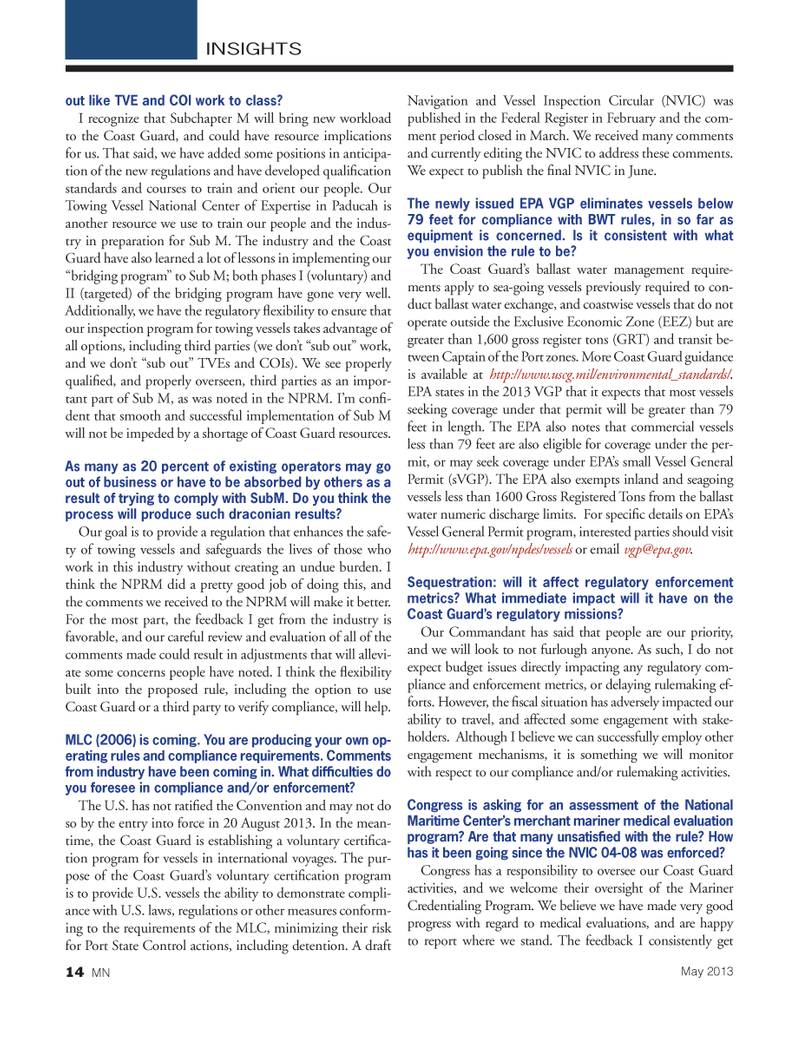
Page 14: of Marine News Magazine (May 2013)
Combat & Patrol Craft Annual
Read this page in Pdf, Flash or Html5 edition of May 2013 Marine News Magazine
out like TVE and COI work to class? I recognize that Subchapter M will bring new workload to the Coast Guard, and could have resource implications for us. That said, we have added some positions in anticipa- tion of the new regulations and have developed qualiÞ cation standards and courses to train and orient our people. Our Towing Vessel National Center of Expertise in Paducah is another resource we use to train our people and the indus- try in preparation for Sub M. The industry and the Coast Guard have also learned a lot of lessons in implementing our Òbridging programÓ to Sub M; both phases I (voluntary) and II (targeted) of the bridging program have gone very well. Additionally, we have the regulatory ß exibility to ensure that our inspection program for towing vessels takes advantage of all options, including third parties (we donÕt Òsub outÓ work, and we donÕt Òsub outÓ TVEs and COIs). We see properly qualiÞ ed, and properly overseen, third parties as an impor- tant part of Sub M, as was noted in the NPRM. IÕm conÞ -dent that smooth and successful implementation of Sub M will not be impeded by a shortage of Coast Guard resources. As many as 20 percent of existing operators may go out of business or have to be absorbed by others as a result of trying to comply with SubM. Do you think the process will produce such draconian results? Our goal is to provide a regulation that enhances the safe- ty of towing vessels and safeguards the lives of those who work in this industry without creating an undue burden. I think the NPRM did a pretty good job of doing this, and the comments we received to the NPRM will make it better. For the most part, the feedback I get from the industry is favorable, and our careful review and evaluation of all of the comments made could result in adjustments that will allevi- ate some concerns people have noted. I think the ß exibility built into the proposed rule, including the option to use Coast Guard or a third party to verify compliance, will help. MLC (2006) is coming. You are producing your own op- erating rules and compliance requirements. Comments from industry have been coming in. What difÞ culties do you foresee in compliance and/or enforcement? The U.S. has not ratiÞ ed the Convention and may not do so by the entry into force in 20 August 2013. In the mean- time, the Coast Guard is establishing a voluntary certiÞ ca-tion program for vessels in international voyages. The pur- pose of the Coast GuardÕs voluntary certiÞ cation program is to provide U.S. vessels the ability to demonstrate compli- ance with U.S. laws, regulations or other measures conform- ing to the requirements of the MLC, minimizing their risk for Port State Control actions, including detention. A draft Navigation and Vessel Inspection Circular (NVIC) was published in the Federal Register in February and the com- ment period closed in March. We received many comments and currently editing the NVIC to address these comments. We expect to publish the Þ nal NVIC in June. The newly issued EPA VGP eliminates vessels below 79 feet for compliance with BWT rules, in so far as equipment is concerned. Is it consistent with what you envision the rule to be? The Coast GuardÕs ballast water management require- ments apply to sea-going vessels previously required to con- duct ballast water exchange, and coastwise vessels that do not operate outside the Exclusive Economic Zone (EEZ) but are greater than 1,600 gross register tons (GRT) and transit be- tween Captain of the Port zones. More Coast Guard guidance is available at http://www.uscg.mil/environmental_standards/ . EPA states in the 2013 VGP that it expects that most vessels seeking coverage under that permit will be greater than 79 feet in length. The EPA also notes that commercial vessels less than 79 feet are also eligible for coverage under the per- mit, or may seek coverage under EPAÕs small Vessel General Permit (sVGP). The EPA also exempts inland and seagoing vessels less than 1600 Gross Registered Tons from the ballast water numeric discharge limits. For speciÞ c details on EPAÕs Vessel General Permit program, interested parties should visit http://www.epa.gov/npdes/vessels or email [email protected] .Sequestration: will it affect regulatory enforcement metrics? What immediate impact will it have on the Coast GuardÕs regulatory missions? Our Commandant has said that people are our priority, and we will look to not furlough anyone. As such, I do not expect budget issues directly impacting any regulatory com- pliance and enforcement metrics, or delaying rulemaking ef- forts. However, the Þ scal situation has adversely impacted our ability to travel, and affected some engagement with stake- holders. Although I believe we can successfully employ other engagement mechanisms, it is something we will monitor with respect to our compliance and/or rulemaking activities. Congress is asking for an assessment of the National Maritime CenterÕs merchant mariner medical evaluation program? Are that many unsatisÞ ed with the rule? How has it been going since the NVIC 04-08 was enforced? Congress has a responsibility to oversee our Coast Guard activities, and we welcome their oversight of the Mariner Credentialing Program. We believe we have made very good progress with regard to medical evaluations, and are happy to report where we stand. The feedback I consistently get INSIGHTS14 MNMay 2013MN May2013 Layout 1-17.indd 14MN May2013 Layout 1-17.indd 145/3/2013 12:49:21 PM5/3/2013 12:49:21 PM

 13
13

 15
15
